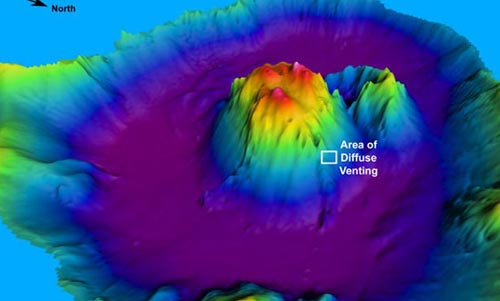 |
New Undersea Volcano Eruptions Possible Off Oregon Coast
Published 05/01/2015

(Newport, Oregon) – The Oregon coastline may have a new volcano.
This one is underwater and some 250 miles offshore, lurking in an area known as the Axial Seamount that has been studied for years by scientists from the Hatfield Marine Science Center in Newport and many others.
Scientists picked up a swarm of underwater quake activity starting last Friday, where thousands of tiny events shook the Axial, while the seafloor actually dropped nearly eight feet. This, say scientists, is generally a sign magma is moving updwards through the Earth. Beneath the Axial lies a reservoir of the hot stuff, but researchers say it's still too early to tell what exactly has happened out there.
Two scientists have already correctly predicted one eruption that occurred in 2011, and this one was even more exact. Geologists Bill Chadwick of Oregon State University and Scott Nooner of the University of North Carolina Wilmington forecast last September that another eruption would hit in 2015.
The first time around, Nooner predicted in 2006 that an eruption would happen by 2014.
Nooner and Chadwick based these predictions on their own previous research, which has been funded by the National Science Foundation (NSF) and the National Oceanic and Atmospheric Administration (NOAA).
Chadwick said it's possible all the current activity is the result of a large intrusion of magma that hasn't reached the surface yet.
“There are some hints that lava did erupt, but we may not know for sure until we can get out there with a ship,” he said.
Whatever happened, none of the eruptions pose any threat to the Oregon coast. Quakes at the Axial Seamount and any resultant movements of the seafloor are small, thus posing no risk of a tsunami generated from below.
Axial Seamount has long proven an ideal laboratory, with a close proximity to central Oregon coast docks and a unique structure. It's also sitting on thin ocean crust, giving it a “plumbing system” not as complex as most volcanoes, Chadwick said.
“Thus Axial can give us insights into how volcano magma systems work – and how eruptions might be predicted,” Chadwick said.
The area sits on the Juan de Fuca Ridge, where two tectonic plates are separating. The Pacific Plate is moving to the west and the Juan de Fuca plate is moving to the east. As the plates separate, magma that is generated in the Earth’s mantle rises up and erupts on the seafloor to create new ocean crust.
In an article earlier this year on Oregon Coast Beach Connection, Chadwick said volcanoes are notoriously difficult to forecast, so monitoring Axial Seamount and its quirks is of high importance. Referring to an earlier eruption, Chadwick noted how deep sea warm water vents change and thus can alter the environment there.
"When eruptions like this occur, a huge amount of heat comes out of the sea floor, the chemistry of sea floor hot springs is changed, and pre-existing vent biological communities are destroyed and new ones form. Some species are only found right after eruptions, so it is a unique opportunity to study them," Chadwick said.
Next up: Chadwick and Nooner will head back to Axial in late summer to gather more data, but other researchers may visit sooner. Scientists still need to confirm the eruption and then measure the volume of lava moving through the area.
Below: Axial Mount in 2011


More Oregon coast below:



More About Oregon Coast hotels, lodging.....
More About Oregon Coast Restaurants, Dining.....
LATEST Related Oregon Coast Articles
Whale Body Parts Found on Oregon Coast - Two Whales Strand on Washington Coast |
Back to Oregon Coast
Contact Advertise on BeachConnection.net
All Content, unless otherwise attributed, copyright BeachConnection.net Unauthorized use or publication is not permitted
Secrets of the Season |
Unusual Travel Articles TravelParanormal.com allows you to submit your own creepy tale or debunk one - or see up-to-the-minute news headlines about travel and the paranormal. News Headlines from All Over Oregon Need to scan Oregon headlines? Constantly updated news from all over Oregon: a comprehensive, up-to-the-minute display of news headlines from a variety of media Oregon Coast Oceanfront Lodging, Hotels, Rentals |






































